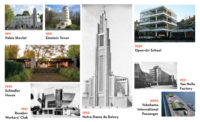When it comes to the windows of historic buildings, both the National Park Service and the National Trust for Historic Preservation agree: it’s better to repair original casements than replace them with updated copies. But when the windows are beyond salvageable or for a new building in a landmarked district, “the challenge is replicating the existing historic fabric while meeting performance and operational needs,” says Matt Kraus, vice president of Skyline Windows. In 1990, the company introduced its first casement designed in accordance with the New York City Landmark Preservation Commission’s guidelines. Skyline’s latest option, the Series 97 multilock with pull handle, features a grip at the bottom that allows the window to be opened from a wheelchair.
Another modern-day interpretation is Graham Architectural Products' SR6700 series of steel-replication windows. These aluminum-extruded models, which feature traditional concave muntins and applied grids, are available in fixed or projected styles.
Increased thermal and acoustic requirements also have made creating quality replacement windows trickier. However, the historically accurate Custom Window 8300 from Wausau Window and Wall Systems may be specified with high-performance glass, sound-reducing glazings, and a polyurethane thermal barrier “capable of achieving a U-factor as low as 0.38 BTU/hr. per square foot,” according to Steve Fronek, PE, vice president of technical services at Wausau.
The windows, which have been approved for use in buildings on the National Register of Historic Places, also may be customized with rebates that match frames of old. CIRCLE 246








